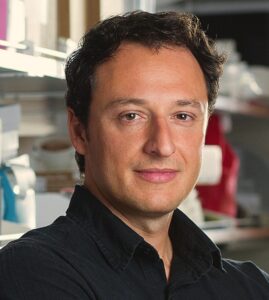By Don C. Reed

Alysson Muotri in his lab and office at Sanford Consortium in La Jolla, California on Tuesday May 14, 2013. Photograph by David Ahntholz
http://www.twopointpictures.com
http://www.davidahntholz.com
Imagine a beloved infant child, and he/she smiles at you — but there is something wrong. You wait for the precious little words, the garbled “baby talk” which will gradually polish into speech — but it doesn’t come.
Autism is an array of “developmental disorders, genetic conditions called Autism Spectrum Disorders (ASD)” (1) with many possible consequences, including the loss of speech.
While individuals with less severe autism might not need any medical intervention but social inclusion, many others on the other end of the spectrum have severe clinical trajectories, including co-morbidities such as epilepsy, aggression, anxiety, etc.
Some autistic children literally never say a word their entire lives. The problem of autism is immense, with one in sixty-eight people affected by the condition. It strikes males four times as often as females. For the ones with profound autism, science is the only hope.
One major problem is the lack of autism “models” to test therapies on. Mice models are not as useful here due to the greater complexity of the human brain. Also, rodents do not socialize or talk as humans do, making modeling difficult.
One hope is to find a drug already FDA-approved (thereby avoiding many new expensive tests) that will alleviate the symptoms, or even the genetic cause of the condition. The idea is to take skin cells from the patients, convert them into stem cells, (induced Pluripotent Stem Cells, iPSC) and from there create brain cells to understand the impact of genetics on the proper brain function. With that, you can screen drugs that can help to ameliorate the problems in the dish, in hopes they would do the same in patient’s brains.
One enterprising doctor, Alysson Muotri, used the non-invasive strategy called the “Tooth Fairy” method to obtain tissue samples from autistic children, when they put their own lost teeth under the pillow. Cells in the deciduous teeth can be sent to the Muotri lab for analyses.
In the Muotri lab, the reprogrammed dental pulp cells are used to generate a “mini-brain” from the donor individual. The scientific name for “mini-brain” is brain organoid, a self-assembled, tri-dimensional tissue that mimics the neurodevelopment of that person… in the controlled condition of the lab.
Dr. Muotri has used these brain organoids to help fight the Zika outbreak in Brazil. Using this tool, Dr. Muotri was able to confirm that the Zika virus was responsible for the congenital birth defects and microcephalic babies born in the Northeast of the country. More importantly, in less than two years, he moved from causation to treatment, using his model to screen for pre-approved FDA anti-virals that could block the Zika replication and protect baby brains from infected mothers. Not bad for a “mini-brain”!
An autistic person’s expenses over a lifetime may exceed $3.2 million. And the greatest worry of the parent of a child with autism: “what will happen to my child when I am gone?” All too often, the government programs of care will end when the child reaches 21. The condition, however, does not end.
Dr. Muotri has made progress for several conditions under the umbrella of autism. “We showed that we could rescue defects in synaptogenesis, using a collection of FDA-approved drugs in brain cells derived from Rett syndrome patients”. (2) A derivative of these one of drugs, IGF-1, is now approved and commercialized under the name of Daybue.
Progress was also made with a gene therapy approach. By delivering the correct copy of the gene to brain cells, it might be possible to compensate for the genetic mutations causing these syndromes. For Pitt-Hopkins Syndrome (another condition under ASD), the mutated gene is called TCF4. Dr. Muotri showed that scientists can deliver the non-mutated copy of TCF4 into brain organoids generated from Pitt-Hopkins patients using a neutral recombinant viral vector. Upon entering the cells, the virus transfers the non-mutated copy of TCF4 to the diseased brain cells, making them work normally. (emphasis added) With this proof-of-principle approach, Dr. Muotri and other scientists hope to accelerate the discoveries made inside the labs to clinical trials. –personal communication
A more effective treatment remains elusive, but progress is genuine.
Dr. Muotri’s research has benefited from grants from the California Institute for Regenerative Medicine. (3)
1. https://www.cirm.ca.gov/our-progress/people/alysson-r-muotri/
2. https://www.cirm.ca.gov/our-progress/disease-information/autism-fact-sheet